AMD Zen 4 Ryzen 9 7950X and Ryzen 5 7600X Review: Retaking The High-End
by Ryan Smith & Gavin Bonshor on September 26, 2022 9:00 AM ESTDDR5 & AMD EXPO Memory: Memory Overclocking, AMD's Way
The final major feature being introduced with the AM5 platform is DDR5 memory support. Like AM4, which was introduced alongside AMD’s shift over from DDR3 to DDR4, socket AM5 is being rolled out to bring support for DDR5 for the platform.
In fact, socket AM5 only brings DDR5 support. Unlike rival Intel, who opted to support both DDR4 and DDR5 memory with their Alder Lake (12th Gen Core) CPUs, AMD is only supporting DDR5 on the AM5 platform. This is a true platform limitation, and there is no going back.
Like other engineering decisions, this marks a trade-off being made by AMD. In the short term, this is going to drive up the total cost of an AM5 system relative to a theoretical AM5 system with DDR4 memory; DDR5 simply costs more right now. But at the same time, it simplifies things over the long run of the platform, especially since AMD is planning on supporting it through 2025. There will be no such thing as a DDR4 AM5 motherboard, and AMD needs not bake DDR4 support into any of the Ryzen memory controllers.
Ultimately, with AMD starting the DDR5 transition roughly a year after Intel, the company’s expectations are that DDR5 prices are going to continue falling fast enough that they’re going to reach parity with DDR4 before too long. So why implement DDR4 support if it’s only going to be necessary for a short period of time?
As for memory speeds and capacities supported, while AM5 enforces the use of DDR5, ultimately it’s the individual memory controllers that determine the rest. For AMD’s Ryzen 7000 desktop processors, which are based on the Zen 4 Raphael design, these chips offer support for official (JEDEC) speeds at up to DDR5-5200 for a 1 DIMM Per Channel (DPC) configuration. But, like all other DDR5 products we’ve seen thus far, 2 DPC comes with a significant penalty; in that case the maximum JEDEC speed is reduced to just DDR5-3600.
So as was the case with Intel’s Alder Lake platform, system builders are going to need to put a lot more thought into how they go about adding memory, and how they’re going to handle future memory expansion, if at all. While Ryzen 7000 can drive a 2 DPC/4 DIMM setup, you’re going to lose 31% of your memory bandwidth if you go that route. So for peak performance, it’ll be best to treat Ryzen 7000 as a 1 DPC platform.
Meanwhile, for system builders looking at reliability and data integrity as opposed to performance, AMD has confirmed that Ryzen 7000 also supports ECC memory. Unfortunately, the compatibility situation is essentially unchanged from the AM4 platform, which is to say that while the CPU supports ECC memory, it’s going to be up to motherboard manufacturers to properly validate it against their boards. For boards that aren’t doing validation, AMD can’t guarantee ECC is going to work. Though it’s largely a moot point for today’s launch anyhow, since although DDR5 ECC UDIMMs exist, they are in very short supply.
Also, while we didn’t expect it to be supported to begin with, AMD has confirmed that Ryzen 7000 won’t support RDIMMS/LRDIMMs. So it’s unbuffered DIMMs all the way.
Overclocking Memory Ratios
JEDEC standard speeds aside, the Ryzen 7000 series will also support memory overclocking. And thanks to a combination of the switch to DDR5 memory, changes to AMD’s memory controllers, and changes to AMD’s power delivery infrastructure, the rules have changed.
On Ryzen 5000, the ideal configuration for memory overclocking was to run the fabric clock, memory controller, and memory clock all in sync at the same frequencies. This made DDR4-3600 the typical “sweet spot” for the platform, as going faster would typically require running parts of the CPU out of sync so that they could stay within their own attainable clockspeeds.
But for Ryzen 7000, AMD has loosened things up a bit. Ryzen 7000 systems can still get improved memory performance even when the fabric clock is allowed to go out of sync with the memory controller. As a result, most overclockers can just leave that clock set to Auto, and instead focus on keeping the memory and memory controller clocks in sync in a 1:1 ratio.
Specifically, when the fabric clock is set to Auto, it’s typically run at 2000MHz. Meanwhile the memory and memory controller clocks will be running at anywhere between 2400MHz and 3000MHz, depending on the speed of the RAM kit used. Ultimately, the goal for the best performance is to get the fabric clock to 2000MHz and then keep the memory/MC clock at 3000MHz or less. Otherwise, if memory speeds exceed 3000MHz (DDR5-6000), then the memory controller will fall to 1:2 with the memory frequency, which will incur a performance hit.
It should be noted that AMD’s idea of optimal memory speeds here is high memory clocks with low memory latencies, rather than pushing the absolute fastest memory clocks. On good chips it should be possible to drive Ryzen 7000 at speeds above DDR5-6000, but the latency hit from things falling out of sync will be significant – enough so that it’s likely going to be a performance regression for most workloads.
Overclocking with EXPO
But for most users doing memory overclocking, they’re likely going to simply rely on factory overclocked memory kits with pre-programmed profiles. And this is where AMD is rolling out their own standard for those memory kit profiles: EXPO.
AMD EXPO stands for EXtended Profiles for Overclocking and is designed to provide users with high-end memory overclocking when used in conjunction with AMD's Ryzen 7000 series processors. Similar to Intel's preexisting X.M.P (Extreme Memory Profile) technology found on most consumer-level memory kits designed for desktop Intel platforms, AMD's EXPO technology aims to do the same, but as an open standard with an emphasis on providing the best settings for AMD platforms.
The premise of AMD EXPO is that is a one-click DDR5 overclocking function for AM5 motherboards. On the surface EXPO is essentially a set of X.M.P-like profile specifically designed for AMD's Ryzen 7000 (Zen 4) processors.
The major impetus behind EXPO is two-fold. The first is simple: Intel doesn’t share XMP. There’s no published specification for it, and while AMD has reverse engineered it to some extent, they can’t be sure of what’s going on (especially with DDR5/XMP 3). So rather than deal with the potential compatibility issues and inefficiencies, they’re just going their own way. The second benefit for EXPO being that it means that memory kit manufacturers can then create memory profiles that are AMD-specific, potentially using tighter sub-timings that are possible in conjunction with AMD processors, but not with Intel’s.
It is worth noting that, despite the existence of EXPO, DDR5 memory with X.M.P profiles will be supported on Ryzen 7000 platforms. Still, AMD is very clearly pushing customers towards using EXPO DIMMs with their systems to get the best performance out of AMD systems.
As for EXPO itself, like most other AMD standards, the company is making this an open and royalty free standard (XMP is believed to have royalties, but how much has never been officially published). So memory kit partners will be able to implement EXPO profiles without the blessing of AMD, or needing to pay AMD for the privilege.
With that said, EXPO will be a self-certification program. So AMD is not charging anything for it, but at the same time they are not doing much in the way of extra work to validate support for it.
In lieu of that, memory kit manufacturers will be required to publish their self-certification reports. These reports will lay out in detail what memory was tested on what systems, and with what timings and voltages. The idea here being that openness goes both ways, and that buyers should be able to see complete configuration settings a profile calls for. The detailed data is in some respects overkill, but it also means that if memory kit manufacturers opt for a high-clocked kit with tight primary timings and loose secondary timings, potential customers will be able to see those full timings in advance.
As with manual memory overclocking, AMD expects the sweet spot for EXPO kits to be DDR5-6000. In an example profile provided for a 2 x 16GB G.Skill memory kit, that kit runs at DDR5-6000 CL30, with a VDD voltage of 1.35v. It’s kits like these that AMD expects to provide the best performance, offering rather low memory latencies in conjunction with a more modest increase in memory frequency.
The specific performance gains will vary depending on the workloads. But for gaming tasks, some of the most DRAM latency-sensitive workloads, AMD is touting performance gains of up to 11% at 1080p. Otherwise, at more GPU-limited resolutions and settings, the gains will be understandably lower.


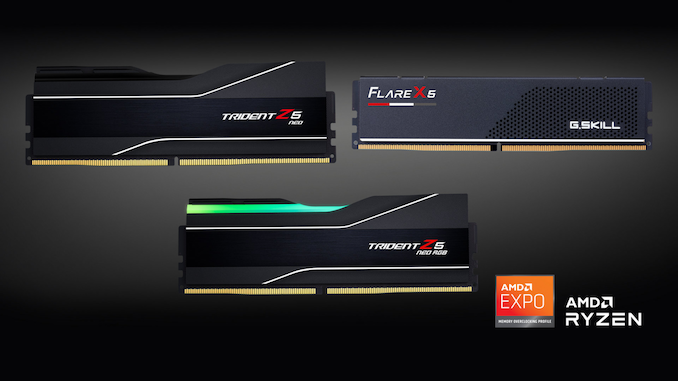
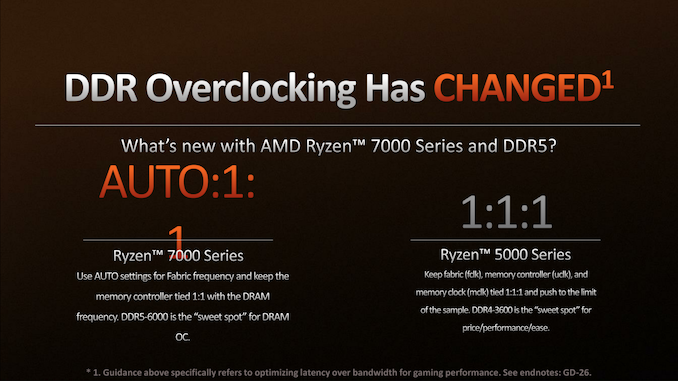
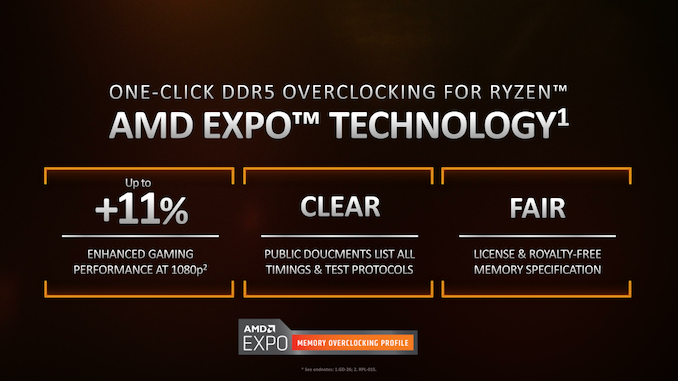
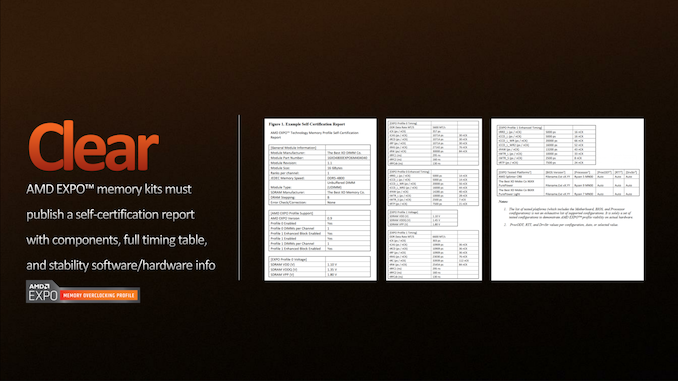
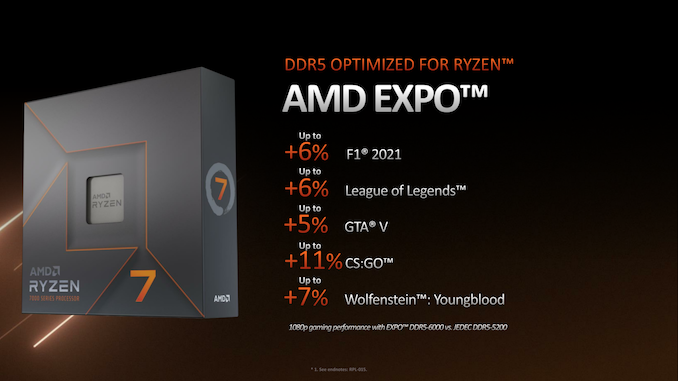








205 Comments
View All Comments
emn13 - Monday, September 26, 2022 - link
The geekbench 4 ST results for the 7600x seem very low - is that benchmark result borked, or is there really something weird going on? Replyemn13 - Monday, September 26, 2022 - link
Sorry, I meant the geekbench 4 MT not ST results. The score trails way behind even the 3600xt. ReplySilver5urfer - Monday, September 26, 2022 - link
Good write up.First I would humbly request you to please include older Intel processors in your suite, it will be easier to understand the relative gains for eg the old 9th gen, 10th gen as a reliable place I see things all over on other sites, AT is at-least consistent so would be better if we have a ton of CPUs in one spot. Thanks
Now speaking about this launch.
The IOD is now improved by a huge factor so no more of that IF clock messing with the I/O controller and high voltage on the Zen 3 likes it's all improved so I think the USB fallout issues are fixed on this platform now. Plus the DP2.0 on iGPU is a dead giveaway on RDNA3 with DP2.0 as well.
IMC is also improved looking at it AMD operated with synchronized clocks with DRAM now they can do it without that since IF is now at 2000MHz and the IMC and DRAM are higher at 3000MHz to match the DDR5 data rates. Plus the EXPO is also lower latency, however the MCM design causes the AIDA benchmark to have high latency vs Intel even though Intel is operating at Gear 2 ratio with similar Uncore decoupled. Surprisingly the inter core latencies did not change much, maybe that's one of the key to improving more on AMD side gotta see what they will do for Zen 5.
The CPU clocks are insane, 5GHz on all 16C32T is a huge thing, plus even the 7600X is hitting 5.4GHz. Massive boost from AMD improving their design, plus the TSMC5N High Performance node is too good. However AMD did axed their temps and power. It's a very good move to not castrate the CPU with power limits and clocks now that's out it gets to spread it's wings. But the downside is, unlike Intel i7 series Ryzen 6 also gets hot meaning the budget buyers need to invest money in AIO vs older Zen 3 being fine on Air. That's a negative effect for AMD when they removed the Power Limits like Intel and let these rip to 250W.
Chipset downlink capping at PCIe4.0x4 was the biggest negative I can think of it, because Intel DMI is now 4.0x8 on ADL and RPL, RKL had it at 3.0x8 CML at 3.0x4. AMD is stuck to 4.0x4 from X570. Many will not even care, but it is a disadvantage when you pay top money for X670E they should have given us the PCIe5.0x4, AMD will give that in 2024 with Zen 5 X770 chipset that's my guess.
The ILM backplate engineering is solid that alone and the LGA1718 AM5 longevity itself is a major PLUS for AMD over LGA1700's bending ILM and EOL by 13th gen. Yes the 12th gen is a better purchase given how the Cooling requirement for i7 and i5 is not this high like R6 and R7 and the cheaper board costs plus 13th gen is coming and AMD's platform is new as well you would be a guinea pig. Depends on what people want and how much they can spend and what they want in longevity.
Performance is top notch for 7600X and 7950X absolute sheer dominance but the pricing is higher when you see the % variance vs Zen 3 and Intel 12th gen parts, and added AIO mandatory because they are hot. The gaming performance is as expected not much to see here and the 5800X3D still is a contender there but to me that chip is worthless as it cannot match any processor in high core count workloads. Although 7600X is a champion 6C12T and it beats 12C24T in many things and the 10C20T 10th gen Intel too. IPC is massive in ST and MT workloads as expected. AMD Zen 4 will decimate ARM, Apple has only one thing lol muh efficiency all that BGA baggage, locked down ecosystem is free.
RPSC3 perf at TPU's Red Dead Redemption is weird as I do not see any gains over Intel, given how much of a beast this AVX512 is on Zen 4 with 2x256Bit without AVX offset that too maybe they are not using AVX512. Plus their AMD Zen 3 gauging is also bad because they do not work well vs Intel 9th gen even, I wish you guys cover Dolphin emu, PCSX2, RPCS3 and Switch Emulators.
I think best option is to wait for next year and buy these parts as they will drop, right now no PCIe5.0 SSD in high capacity. no PCIe5.0 GPU even that Nvidia skimped on it. No use of the new platform unless one is running a super damn old CPU and GPU setups.
Shame that OC is totally dead, Zen 3 was hamfisted with its Curve Optimizer and Memory tuning becoming a head ache due to how AGESA was handled and the 1.4v high voltage and lack of documentation. Zen 4 it's even 1.0-1.2v still no OC because AMD's design basically is now pushed to maximum with it's Core TJMax temps and how it works on the basis of Core temperatures over everything else. There's no room here, AIO is saturated with 90C here. Too high heat density on AMD side similar to Intel 11th and 12th gen. Although Intel can go upto 350W and hit all cores at higher vs AMD 250W max. Well OC was on life support, only Intel is basically keeping it alive at this point after 10th gen it became worse and 12th very hot and high heat and now 13th gotta see if that DLVR regulator helps or not.
All in all a good CPU but has some downsides to it. Not much worth for existing 2020 class HW folks at all. Better wait when DDR5 matures even further and more PCIe5.0 becomes prevalent. Reply
Threska - Monday, September 26, 2022 - link
Maybe people will start delidding.https://youtu.be/y_jaS_FZcjI Reply
Silver5urfer - Tuesday, September 27, 2022 - link
That Delid is a direct die, it will 100% ruin the AM5 socket for longevity and the whole CPU too. That guy runs HWBot, ofc he will make a video on his bs delid kits. Nobody should run any CPU completely blowing the IHS off. You will have a ton of issues with that. Water leak, CPU silicon die crack due to Thermodynamics and the pressure differences over the time, Liquid Metal leak. Total bust of Warranty on any parts once that LM drops on your machine game over for $5000 worth rig there.AMD should have done some more improvements and reduced the max TJ Max to say 90 at-least but it's what it is unfortunately (for high temps and cooling requirements) and fortunately (to have super high performance) Reply
Threska - Tuesday, September 27, 2022 - link
There are some in the comments both wondering if lapping would achieve the same and the thicker lid was giving some room for future additions like 3D cache, etc. Replyabufrejoval - Wednesday, September 28, 2022 - link
I'm not sure that PCIe 4.0 "DMI" downlink capping is a hard cap per se by the SoC, but really the result of negotiations with the ASmedia chipset, which can't do better. I'd assume once someone comes up with a PCI 5.0 chipset/switch, there is no reason it won't do PCIe 5.0. It's just a bunch of 4 lanes, that happen to be connected to ASmedia PCIe 4.0 chips on all currrent mainboards.Likewise I don't see why you couldn't add the second chipset/switch to the "NVMe" port of the SoC or any of the bifurcated slots: what you see is motherboard design choices not Ryzen 7000 limitations. That just has 24 PCIe 5.0 lanes to offer in many bundle variants. It's the mainboard that straps all that flexibility to slots and ports.
I don't see that you have to invest into AIO coolers, *unless* you want/need top clocks on all cores. E.g. if your workloads are mixed, e.g. a few threads that profit from top clocks for interactive workloads (including games) and others that are more batch oriented like large compiles or renders, you may get maximum personal value even from an air cooler that only handles 150 Watts.
Because the interactive stuff will rev to 5.crazy clocks on say 4-8 cores, while for the batch stuff you may not wait in front of the screen anyway (or do other stuff while it's chugging in the background). So if it spends 2 extra hours on a job that might take 8 hours on AIO, that may be acceptable if it saves you from putting fluids into your computer.
In a way AMD is now giving you a clear choice: The performance you can obtain from the high-end variants is mostly limited by the amount of cooling you want to provide. And as a side effect it also steers the power consumption: you provide 150 Watts worth of cooling, it won't consume more except for short bursts.
In that regard it's much like a 5800U laptop, that you configure between say 15/28/35 Watts of TDP for distinct working points in terms of power vs. cooling/noise (and battery endurance).
Hopefully AMD will provide integration tools on both Windows and Linux to check/measure/adjust the various power settings at run-time, so you can adjust your machine to your own noise/heat/performance bias, depending on the job it's running. Reply
Dug - Monday, September 26, 2022 - link
"While these comments make sense, ultimately very few users apply memory profiles (either XMP or other) as they require interaction with the BIOS"This is getting so old. Your assumption is incorrect which should be obvious by the millions of articles and youtube videos on building computers. Not to mention your entire article is not even directed to "general public" but to enthusiasts. Otherwise why write out this entire article? Just say you put a cpu in a motherboard and it works. Say it's fast. Article done.
Why not test with Curve Optimizer? Reply
Oxford Guy - Tuesday, September 27, 2022 - link
This text appears again and again for the same reason Galileo was placed under house arrest. Replysocket420 - Monday, September 26, 2022 - link
Could someone, preferably Ryan or Gavin, please elaborate on what this sentence - "the new chip is compliant with Microsoft’s Pluton initiative as well" - actually means? This is the only review I could find that mentions Pluton in conjunction with desktop Zen 4 at all, but merely saying it's "compliant" is a weird way of wording it. Is Pluton on-die and enabled by default in Ryzen 7000 desktop CPUs? Reply